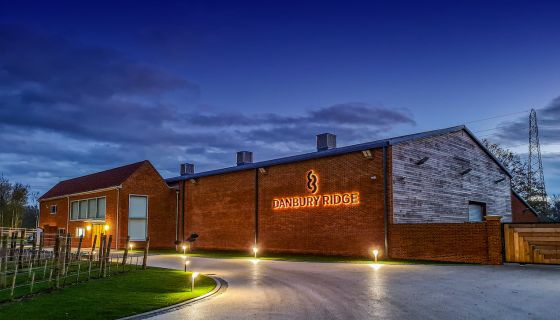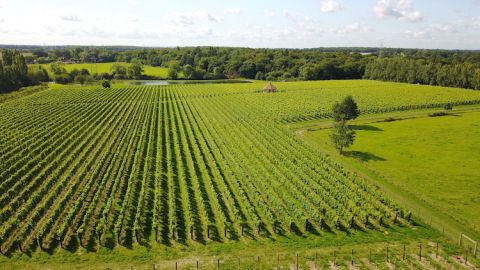Ever-warmer summers keep delivering more and more wines that would have been unthinkable two or three decades ago when the grapes would simply not have been ripe and healthy enough: Norwegian Riesling, Nova Scotia fizz, Belgian Chardonnay to rival Puligny-Montrachet, and really serious still wines from regions previously associated with sparkling wine.
Base wines for sparkling wine should be nice and tart so that the finished wine is still appetising despite the added sugar and yeast needed to produce the bubbles. So Champagne and England, with their cool climates and only-just-ripe, high-acid grapes, were natural sources of sparkling wine.
On visits to Champagne in the last century I would occasionally be offered examples of the still wine produced from Champagne grapes, called Coteaux Champenois and, with the occasional exception of Bollinger’s La Côte aux Enfants from a particularly sunny slope of Pinot Noir next to the Bollinger headquarters in the village of Aÿ, I would always think that these pretty sour liquids proved why champagne had bubbles in it.
Similarly, English vineyards proved their worth towards the end of the last century when they started producing convincing sparkling wine made from the same grapes and methods as champagne but with their own distinctive character. Most still English wines then were a bit too meagre, and obviously made from less-than-fully-ripe grapes.
But all this is changing. On my last visit to Champagne, in 2019, several producers showed me with pride the still wines they had been working on. Charles Heidsieck has been developing a range of very respectable still Chardonnays from different villages known for that grape variety. And, most exciting of all, perhaps the most admired winemaker in Champagne, Louis Roederer’s Jean-Baptiste Lécaillon, poured the 2015 and 2016 vintages of a still red project he has been working on since way back in the late 1990s when he started to analyse the make-up of the many vineyards owned by the house. He was looking not for the chalk that is so suitable for growing grapes for sparkling wine, but for the clay favoured for still Pinot Noir.
The first plot chosen specifically to produce still red was the 0.43-ha (1-acre) Charmont parcel of white clay in Mareuil-sur-Aÿ, which was planted in 2002 with a mass selection of vines from Burgundy. ‘It would have taken us 15 to 20 years to find a similar mass selection in Champagne’, according to Lécaillon, who has many friends in Burgundy. They have since identified and planted several other plots of vines specifically destined to make still wine.
While the Charmont vines were establishing a decent root system, their produce went into Roederer’s non-vintage blend Brut Premier but in 2014 Lécaillon decided it was worth having a go at a still wine. ‘But it didn’t work very well’, confessed Lécaillon via Zoom. ‘I was still too Champenois and waited too long before picking. I waited and waited til we’d reached 13% potential alcohol but it was a complete mistake. The wine was flat. Fruity, but lacking energy, saltiness and structure.’ It too was rejected.
He was happier with the 2015, and misjudged the oak on the 2016. He still has about 1,000 bottles of each vintage so he can monitor the wines’ progress. Rot was such a problem in 2017 that he didn’t even try but finally the 2018 harvest produced a pair of red and white still wines he felt worth releasing. The grapes are picked only about three days after those for sparkling wine, from vines that are specifically trained higher and leafier. After painstaking selection of various ambient, not bought-in, yeasts, he now ages his still wine in a mix of new barrels (now with steam-, not fire-bent staves, to temper the oak influence) and one-year-old barrels, with a portion of the Chardonnay aged in stainless-steel barrels and 250-litre sandstone containers that have about the same permeability as oak.
‘I really wanted to create a modern wine. It has to be delicious and it has to give a lot. I don’t like cherry-like Coteaux Champenois which is more due to a by-product [of champagne production] way of thinking’, according to Lécaillon, whose sparkling results have been sufficiently convincing for the Rouzaud family who own Roederer to give him his head, following his lead to introduce organic and biodynamic viticulture as well as humouring him with a panoply of equipment. This 2018 Camille Pinot Noir manages to combine convincing Pinot character with delicacy and obvious ageing potential.
Roederer will eventually produce a range of still single-vineyard wines branded Camille in honour of Frédéric Rouzaud’s great-grandmother who always served a Coteaux Champenois when entertaining. The white Camille 2018, based on Volibarts, a 0.55-ha (1.4-acre) plot of old Chardonnay vines in Le Mesnil-sur-Oger and inspired by a still 1961 from the same village made in Camille’s era, turned out to be more of a challenge, Lécaillon admits. He didn’t want to make a copy of burgundy. The 2018 is sort of like a Chablis but has a certain Riesling-like quality to it. Promisingly, the Camille wines in my 75-cl sample bottles were still going strong more than 10 days after I opened them and continued to try them.
This pair of wines seems to have raised the bar for Coteaux Champenois in an exciting fashion, although since only 2,880 bottles of red and 1,631 of white were made in 2018, they will not be bargains once they are launched, very selectively, early next month.
But it’s not just Champagne that is, perhaps unexpectedly, producing more and more fine still wine. The 2018 and 2020 vintages have yielded some really exceptional still wines in the vineyards of Britain. Viticultural consultant and Master of Wine Stephen Skelton, who has more than four decades of experience of vine-growing in Britain, reports that in 2020 one English vineyard produced a Chardonnay with 14.7% natural alcohol – and he is consultant to an embryonic wine estate outside Glasgow whose vines will go into the ground next month.
The new English vineyard Danbury Ridge shown above, in a particularly warm corner of Essex, has produced some still 2018 Pinot Noir and Chardonnay that surely break new ground, even if there is now no shortage of producers such as Blackbook, Bolney, Bride Valley, Chapel Down, Gusbourne, Hush Heath, Lyme Bay, Simpsons and Stopham who have made good still English and Welsh wine. Just as chez Roederer, at Danbury Ridge vines were planted and grown specifically to produce still wines, with clones carefully selected for that purpose and the crop thinned to encourage more flavour in the remaining bunches. The results are really very impressive. More detail in this earlier tasting article.
The outer limits of the world wine map are creeping inexorably polewards. Château Reykjavík, anyone?
Some far-northerly still gems
Louis Roederer, Camille Chardonnay 2018 Coteaux Champenois
£130 approx from the likes of Hedonism, Harrods, The Finest Bubble and possibly Selfridges, Fortnum & Mason from May
Louis Roederer, Camille Pinot Noir 2018 Coteaux Champenois
£155 approx from the likes of Hedonism, Harrods, The Finest Bubble and possibly Selfridges, Fortnum & Mason from May
Danbury Ridge Chardonnay 2018 Essex
£32 Swig, £32.50 Grape Britannia, Padstow Wine Co, £32.99 Loki
Danbury Ridge, Octagon Block Pinot Noir 2018 Essex
£54 Swig, £55.50 Grape Britannia, Padstow Wine Co, £55.80 Hedonism
Gusbourne, Guinevere Chardonnay 2018 Kent
£25 producer's website, £27 Quercus Wines, £27.95 Grand Cru Co
Ch de Bousval, Gouttes d’O Chardonnay 2019 Belgium
£34 Haynes Hanson & Clark
Stockists from Wine-Searcher.com















